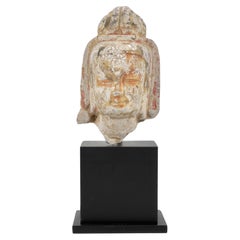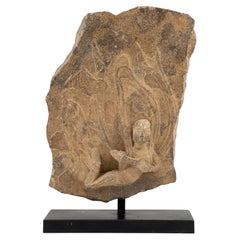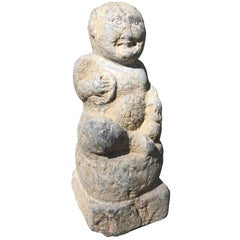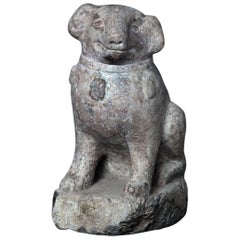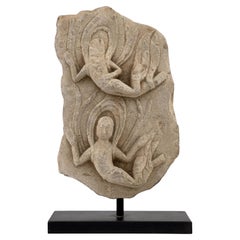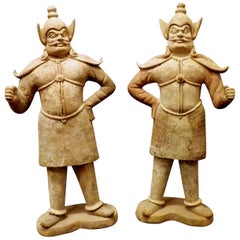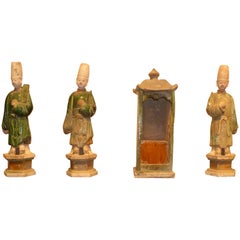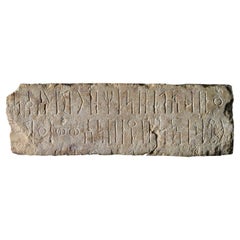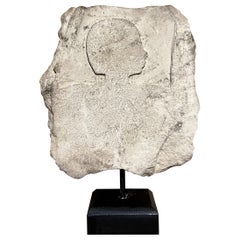Limestone Antiquities
to
6
5
9
8
1
6,703
714
552
497
281
9
9
5
4
9
9
9
Material: Limestone
Ancient China Monumental Stone Ram Han Dynasty, 206BC-220AD
Located in South Burlington, VT
China, a large votive model of a stone ram, Han dynasty (206BC-220AD)
Dimensions: 45cm, 18 inches high and 65cm, 26 inches length and 25cm, 10 inches wi...
Category
15th Century and Earlier Chinese Han Antique Limestone Antiquities
Materials
Limestone
Stone Head of Bodhisattva, Northern Wei-Tang Dynasties
Located in seoul, KR
The face with downcast eyes and a smile, the hair swept up behind the pendulous ears into a high topknot. Faint traces of pigmentation hinting at the sculpture's original polychromy. The black stand was made in Hong Kong at the time of the acquisition.
Date : Northern Wei-Tang Dynasty(5-8th century)
Provenance : Acquired in late 1990s from Hongkong
Reference :
1) Sotheby's London 13 May 2015 - The Soul Of Japanese Aesthetics – The Tsuneichi Inoue Collection - Lot 18
(Price realised : 17,500 GBP / Type : Closely related)
2) Sotheby's New York 26 September 2023 - CHINA / 5000 YEARS - Lot 1156
(Price realised : 8,890 USD / Type : Closely related)
* Stone Head of Bodhisattva...
Category
15th Century and Earlier Hong Kong Tang Antique Limestone Antiquities
Materials
Limestone
$5,196 Sale Price
60% Off
Apsara Carved Limestone Stele with Extremely Rare 'Oolitic silica', Wei Dynasty
Located in seoul, KR
The small dots apparent on the surface of this stone stele are indicative of an oolitic silica structure or oolites formed in what is known as "Oolitic chert." The same phenomenon can also be observed in the Tang Dynasty Limestone Stele at the Asian Art Museum in San Francisco. This formation occurs gradually over the course of thousands to several hundred thousand years within the soil or sea. Similar structures are commonly found in ancient fossils or arrowheads. Ancient peoples chose certain types of stones for tool-making, preferring materials that were easier to work with and could be sharpened effectively. This predilection is believed to be the reason why oolitic silica structures are frequently found in ancient arrowheads.
The development of these oolitic silica structures is a very slow process involving the accumulation of siliceous layers around particulates. This phenomenon, where silica reacts with water to form layers around a nucleus, occurs under specific chemical and physical conditions. Typically, it takes thousands to hundreds of thousands of years for silica to gradually accumulate in layers through contact with moisture, a process that requires a precise harmony of many variables, including chemical conditions, temperature, pressure, pH, and biological activity.
It is known that no other stele with such a silica structure has been identified to date, serving not only as evidence of its authenticity but also significantly enhancing the rarity of this piece.
This stele appears to be a stone sculpture of an apsara, a celestial nymph from Buddhist and Hindu traditions. Despite its fragmentary state, the sculpture conveys grace and movement. The apsara is captured in a dynamic pose, perhaps once part of a larger tableau, playing a flute-like instrument.
The black stand was made in Hong Kong at the time of the acquisition.
Date : Northern Wei/Eastern Wei Dynasty(386~550)
Size : 22cm (Height) x 16cm(diameter)
Condition : Good (oolites dots on surface)
Provenance : Acquired in late 1990s from Hongkong
Reference :
1) Sotheby's New York 20 March 2018 - Jingyatang Treasures Of Chinese Buddhist...
Category
15th Century and Earlier Hong Kong Han Antique Limestone Antiquities
Materials
Stone, Limestone
$14,950 Sale Price
50% Off
China Ancient Stone Entertainer, Han Dynasty 200 AD
Located in South Burlington, VT
China an ancient limestone figure of an Entertainer replete with hands holding tambourines and a top a drum, -for the afterlife- , Han dynasty 206 BC...
Category
15th Century and Earlier Chinese Han Antique Limestone Antiquities
Materials
Limestone
$12,000 Sale Price
20% Off
Important Ancient Chinese Effigy Pug Dog, Ming Dynasty 1368-1644
Located in South Burlington, VT
China, a carving of a canine “Pug”, Ming Dynasty, 1368-1644 CE
Dimensions: 38 cm, 15” High
Photographs taken indoors and out of doors for your viewing pleasure.
The hand carved limestone beast shown on its haunches with naturalistic joyful expression and a well defined compact head, ears, noes, eyes, feet, and tail parted to one side on reverse with distinctive collar ornament seated four square on a thick base all-over showing a weathered surface from significant age.
Formerly exhibited “Asia Week” New York City, Fuller Building, Hutton Gallery 2006.
Provenance: ex collection luoyang, Henan Province, China.
Includes custom display base as shown
Catalog reference: 35 years collecting 35 treasures, Number 35, p.76 (photo)
In ancient China, it is a well-known fact that several types of small dogs were bred and were favored pet gifts between emperors and kings including Lion Dogs, Pekingese and Lo-sze breeds. Some Lo-sze are pictured wearing collars with bells a frequent combination fancied by European royalty of the seventeenth and eighteenth centuries. Lo-sze or pugs were prized for their compact body, good bones, flat face, square jaw, short coat, curled tail, side set back ears, and temperate disposition.
History:
Placing stone animals in important tombs can be traced back at least to the Qin Dynasty (221-206 BCE), some two thousand years ago. In ancient times, stone animals and human figures placed before imperial tombs symbolized royal power and privilege in addition to decorative functions.
The first Ming tomb...
Category
15th Century and Earlier Chinese Ming Antique Limestone Antiquities
Materials
Limestone
$6,800 Sale Price
20% Off
Heavenly Beings Carved Limestone Stele Fragment, Northern/Eastern Wei Dynasty
Located in seoul, KR
Flying two heavenly beings depicted in the stone. They are celestial beings called an Apsara. While having the same fragment and shape, another work I uploaded exhibits small dots on...
Category
15th Century and Earlier Hong Kong Han Antique Limestone Antiquities
Materials
Limestone
$6,435 Sale Price
35% Off
Celestial being(Apsara) Stone Statue, Northern Wei-Tang Dynasty
Located in seoul, KR
This statue appears to be a stone sculpture of an apsara, a celestial nymph from Buddhist and Hindu traditions. Despite its fragmentary state, the sculpture conveys grace and movement. The apsara is captured in a dynamic pose, perhaps once part of a larger tableau, playing a flute-like instrument. The facial features are serene yet expressive, with faint traces of pigmentation hinting at the sculpture's original polychromy. The black stand was made in Hong Kong at the time of the acquisition.
Date : Northern Wei...
Category
15th Century and Earlier Hong Kong Tang Antique Limestone Antiquities
Materials
Stone, Limestone
$4,450 Sale Price
50% Off
Chinese Stone Tabletop Altar, c. 1600
Located in Chicago, IL
This tabletop altar with scrolled edges, a scalloped apron, and turned legs from China's Shanxi province is a rare find. We conservatively estimate it to be late Ming dynasty (circa ...
Category
Early 17th Century Chinese Ming Antique Limestone Antiquities
Materials
Limestone
19th Century Chinese Carved Limestone Statue
Located in Royal Tunbridge Wells, Kent
Antique 18-19th Century Chinese carved limestone sculpture, depicting a horse drawn carriage going over a bridge, being accompanies by serva...
Category
19th Century Chinese Antique Limestone Antiquities
Materials
Limestone
Related Items
Pair of Very Refined Tang Dynasty Pottery Statue of Guardians, Oxford TL Tested
Located in Greenwich, CT
A pair of very refined standing pottery statue of guardians, dramatic facial expression, beautiful detail, early Tang dynasty 618-907, come with one Oxford authentication TL test cer...
Category
15th Century and Earlier Chinese Tang Antique Limestone Antiquities
Materials
Terracotta
$35,000
H 27 in W 12 in D 7 in
Set of Refine Ming Dynasty Green Glazed Attendants and a Sedan Chair
Located in Greenwich, CT
A set of very refined green glazed attendants and one sedan chair, each with benevolent facial expression, beautiful colors and lines, Ming dynasty 1368-1644. Three glazed attendants...
Category
15th Century and Earlier Chinese Ming Antique Limestone Antiquities
Materials
Pottery
$4,800 / set
H 16 in W 5 in D 4 in
Han Dynasty, Rare Antique Chinese Pottery Amphora Decorated with Bronze Ornament
Located in Sampantawong, TH
Rare antique Chinese pottery amphora decorated with bronze ornament.
In the past, this kind of vessel was used for wine container.
Age: China, Han Dynasty, B.C. 206 - A.D. 220
Size...
Category
15th Century and Earlier Chinese Antique Limestone Antiquities
Materials
Pottery
$3,250
H 7.68 in W 8.27 in D 6.89 in
Ancient Indian Red Sandstone Carving Of An Apsaras
Located in Bridgeport, CT
A likely 12-14th Century Northern Indian temple fragment of a female figure or consort known as an Apsaras. Carved in Red Sandstone, the female figure is appropriately attired in bel...
Category
15th Century and Earlier Indian Agra Antique Limestone Antiquities
Materials
Sandstone
Chinese Tang Dynasty Brown Glazed Jar with Lug Handles, 9th-10th Century
Located in Austin, TX
A fine Tang dynasty (618 to 906 AD) brown glazed jar with applied lug handles, circa late 9th or early 10th century, China.
The jar of somewhat st...
Category
15th Century and Earlier Chinese Tang Antique Limestone Antiquities
Materials
Stoneware
Chinese Tang Dynasty Pottery Court Lady
Located in Austin, TX
Painted pottery figure of an opulent Chinese court woman with up-swept hair and standing in a simply draped robe from the Tang Dynasty (618-907 AD). Her beauty is illuminated by the ...
Category
15th Century and Earlier Chinese Tang Antique Limestone Antiquities
Materials
Pottery, Acrylic
Pair of Tang Dynasty Painted Pottery Soldiers
Located in Austin, TX
A well modelled pair of Tang dynasty painted pottery soldiers.
The warriors portrayed standing, dressed in form fitting, elaborate layered Armor with fitted helmets. The breastplate...
Category
15th Century and Earlier Chinese Tang Antique Limestone Antiquities
Materials
Pottery
Tang Dynasty Painted Pottery Horse and Rider, TL Tested
Located in Austin, TX
A charming Tang dynasty painted pottery figure of a horse and mounted noble rider. TL tested by Oxford Authentication.
The horse portrayed standing fours...
Category
15th Century and Earlier Chinese Tang Antique Limestone Antiquities
Materials
Earthenware
Fine Tang Dynasty Pottery Horse, Oxford TL Tested
Located in Greenwich, CT
Tang dynasty pottery statue of standing horse with removable saddle, Tang dynasty 618-907, come with Oxford authentication TL test certificate. Oxford test num...
Category
15th Century and Earlier Chinese Tang Antique Limestone Antiquities
Materials
Terracotta
Earthenware Pottery Jar, Han Dynasty(206 BC-220 AD)
Located in seoul, KR
This jar would have served as a mortuary object (mingqi), placed in a tomb as a substitute for the more valuable bronze and lacquer vessels. Along with a variety of other funerary earthenware objects, attendant figures, and animals, richly decorated vessels of this kind were intended to serve the spirit of the deceased in the afterlife.
Period : Han dynasty
Type : Jar
Medium : Earthenware
Dimension : 28.5 cm(Height) x 11cm(Mouth Diameter)
Condition : Good(Overall in well-preserved ancient burial condition with some soil still adhering (showing minor abrasions and wear due to prolonged burial underground)
Provenance : Acquired in late 1990s from Hongkong
* Han Dynasty Earthenware...
Category
15th Century and Earlier Hong Kong Han Antique Limestone Antiquities
Materials
Earthenware
Large Early Tang Dynasty Painted Pottery Model of a Prancing Horse, TL Tested
Located in Austin, TX
A magnificent and large early Tang dynasty (618-906 AD) model of a prancing or dancing horse, circa 7th century.
The majestic animal is caught mid-motion, one leg raised, head grace...
Category
15th Century and Earlier Chinese Tang Antique Limestone Antiquities
Materials
Pottery
$68,000
H 27 in W 34 in D 10 in
An Important Chinese Carved Wood Figure of Guanyin, Ming Dynasty, 17th Century
Located in ARMADALE, VIC
An Important Chinese Carved Wood Figure of Guanyin, Ming Dynasty, 17th Century
Description:
A dignified portrayal of the bodhisattva, respl...
Category
17th Century Chinese Ming Antique Limestone Antiquities
Materials
Wood
$29,990
H 43.31 in W 20.48 in D 16.93 in
Previously Available Items
Qatabanian Inscription
Located in London, GB
An elegant carved stone inscription, most likely originating from the Wadi Beihan, a valley located in the heartland of the kingdom of Qataban, one of the kingdoms of ancient Yemen. ...
Category
15th Century and Earlier Asian Antique Limestone Antiquities
Materials
Limestone
Egyptian figurative limestone architectural fragment
Located in Vosselaar, BE
A fragment of a trial piece of a relief with the upper body and head of a male figure with cropped hair facing right. New Kindom 1550-1070 bC. Acquired on the London art market 2022.
Category
15th Century and Earlier Egyptian Egyptian Antique Limestone Antiquities
Materials
Limestone
Egyptian limestone architectural fragment
Located in Vosselaar, BE
A fragment of a rectangulare limestone panel from a larger relief with a portion of a extended arm holding a was sceptre. New Kindom 1550-1070 bC.
Category
15th Century and Earlier Egyptian Egyptian Antique Limestone Antiquities
Materials
Limestone
The 'Gillot' Taweret
Located in London, GB
This statuette represents the goddess Taweret, an apotropaic goddess, whose domain was the protection of pregnant women and their babies, especially during childbirth. Her threatenin...
Category
15th Century and Earlier Egyptian Antique Limestone Antiquities
Materials
Limestone
Ushabti of 'Paser'
Located in London, GB
An Ushabti is a funerary figurine used throughout ancient Egypt, placed in a tomb to aid as a servant to the deceased, conducting manual labour for them...
Category
15th Century and Earlier Egyptian Antique Limestone Antiquities
Materials
Limestone
Small Japanese Old Stone / Elephant-Shaped Ornamental Stone / Scholar's Objects
Located in Sammu-shi, Chiba
We Japanese introduce unique items with unique aesthetics, purchasing routes, and ways that no one can imitate.
It is an old Japanese stone.
It is a st...
Category
20th Century Japanese Arts and Crafts Limestone Antiquities
Materials
Limestone
H 4.34 in W 6.3 in D 1.58 in
Torso of a Standing Buddha, China, Northern Qi to Sui Dynasty, 570-600 AD
Located in Kinderhook, NY
Chinese late Northern Qi to early Sui Dynasties (570-600 AD) carved gray limestone torso of the Buddha. Appearing very much like ancient classical West...
Category
15th Century and Earlier Chinese Antique Limestone Antiquities
Materials
Limestone, Steel
China Important Stone Buddhist Memorial Pillar "Chuang" Tang Dynasty, 618-907
Located in South Burlington, VT
China important ancient Buddhist Memorial Sutra Pillar “Chuang”, hand carved hexagonal shaped pillar, limestone, 59? L x 14? D., Tang dynasty (618-907). It is completely covered on a...
Category
15th Century and Earlier Chinese Tang Antique Limestone Antiquities
Materials
Limestone
Ancient Chinese Limestone Altar, late Ming to Qing Dynasty
Located in Chicago, IL
Ancient Chinese limestone altar from the Shanxi Province of China. Late Ming to Qing Dynasty.
Category
18th Century and Earlier Chinese Antique Limestone Antiquities
Materials
Limestone
Stone Buddha Statue Fragment from Northern Wei Dynasty China
Located in Atlanta, GA
A Limestone Head of Buddha with remains of the fragment of the shoulder from Northern Wei Dynasty China (386 to 534 CE). It features a historical ...
Category
15th Century and Earlier Chinese Other Antique Limestone Antiquities
Materials
Limestone
18th Century Bodhisattva Sculpture in Black Limestone, Henan, China
Located in New York, NY
An antique statue of a Bodhisattva, Sanskrit term for one who, motivated by great compassion, demonstrates spontaneous desire to achieve Buddhahood (awakening). This 18th century Chinese sculpture of a Bodhisattva, circa 1760, is carved out of solid black limestone...
Category
1760s Chinese Qing Antique Limestone Antiquities
Materials
Limestone
Antique Indian Hand-Carved Limestone Temple God with Lotus Leaf Motif
Located in New York, NY
This sophisticated hand-carved Indian limestone sculpture was believed to have been executed during the 17th century. This kind of antiquity served as a spiritual guard to temples, and were typically situated at the entrance. The central deity dons a pointed hat and long beard. He holds a staff that extends from his chest to the floor and is surrounded by a wreath of lotus leaves. Typical of antiquities of this age, much of the detail has been softened over centuries, resulting in a sculpture that verges on abstraction resulting in an object that appears simultaneously modern and antiquarian. As a result, it is a timeless piece, as versatile as it is compelling. It would be a wonderful objet d'art in any style of interior from classical to contemporary. This is a particularly example of antique South East Asian art...
Category
17th Century Indian Other Antique Limestone Antiquities
Materials
Limestone, Bronze
Recently Viewed
View AllMore Ways To Browse
Large Chinese Celadon Pots
Antique Slingshot
Bactrian Idol
Gandharan Schist
Geisha Pillow
Han Dynasty Bowl
Khmer Torso
Ancient Luristan Bronze
Chinese Terracotta Army Warriors
Cloisonne Pots Bonsai Trees
Greco Bactrian
Han Dynasty Amphora
Han Dynasty Court Lady
Palanquin Handles
Sancai Phoenix
Schist Gandharan Buddha
Bactrian Stone
Chinese Coconut Cup
